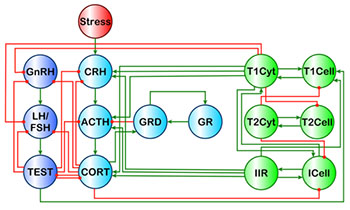


Posted August 21, 2014
Gordon Broderick, Ph.D. and Nancy G. Klimas, M.D., Nova Southeastern University
 The body's response to stress and exertion is controlled with a group of hormones by the hypothalamic-pituitary-adrenal (HPA) axis. Abnormalities within this control system have been observed in veterans with Gulf War Illness (GWI). These hormones control the "fight or flight" response and are profoundly intertwined with the immune system and the control of sex hormones by the hypothalamic pituitary-gonadal (HPG) axis.
The body's response to stress and exertion is controlled with a group of hormones by the hypothalamic-pituitary-adrenal (HPA) axis. Abnormalities within this control system have been observed in veterans with Gulf War Illness (GWI). These hormones control the "fight or flight" response and are profoundly intertwined with the immune system and the control of sex hormones by the hypothalamic pituitary-gonadal (HPG) axis.
In control system theory, it is understood that some combinations of settings will result in smooth, stable operation while others can lead to oscillation or runaway conditions. For example, setting a room air conditioner to a lower temperature than the room heater will yield a situation that is unstable. In this case the settings or "rules" governing the systems are in conflict and the air conditioner will work to cool the room while the heater will work to warm the room. The temperature in the room may oscillate or go to extremes. A combination of settings where the air conditioner is set to a higher temperature than the heater will result in stable operation because the control settings or rules for the two systems are not in conflict. In this example, there are a large number of stable combinations of settings or "rule sets" but more complicated systems may have few or even none at all.
Because of its chronic nature, Drs. Klimas and Broderick suspected that GWI might represent a different (pathological) stable rule set for these control hormone and immune systems-stable, yet well away from the normal range of settings and behavior. To test that possibility, Dr. Broderick and his colleague Dr Travis Craddock used high-performance computers to construct a "mock-up" of the immune, HPA and HPG control system simulating the influences of the hormones, cytokines and other factors in the system on each other using mathematical formulas employing simplifications shown to be valid in engineering control theory. Because of the influence of sex hormones, they constructed both male and female versions of the systems. They then used this simulation to identify several abnormal but stable operating conditions or rule sets.
Dr. Klimas then collected blood samples from patients with GWI and patients with Chronic Fatigue Syndrome (CFS). Her colleague Dr. Mary Ann Fletcher then analyzed these samples to determine if the patterns of hormone and immune proteins (cytokines) expressed corresponded to any of the aberrant stable points predicted by the control theory analysis. The team found that male GWI and CFS subjects had combined levels of key hormone and cytokines that aligned with predicted stable points characterized by hypercortisolism, low testosterone, elevated Th1 inflammatory cytokines, and decreased NK cell activity in conjunction with elevated Th17 response. Male CFS subjects also showed a propensity to resemble stable points with an elevated regulatory T-cell response, suggesting a mixed immune signature for CFS that is not observed in GWI. In contrast, female CFS patients aligned with stable points characterized by hypocortisolism, elevated estrogen, and a shift towards Th2 activation.
Experiments are under way to determine if the simulations suggest a possibility to shift the system away from the pathological stable set points and back to the normal stable operating point by varying hormone levels using specific drugs.

An extended HPA model - An overarching model of control logic regulating the interaction between the main stress response axis (hypothalamic-pituitary-adrenal or HPA-GR), the expression of sex hormones (hypothalamic-pituitary-gonadal or HPG) and the principle branches of innate (IIR) and adaptive immune response (T1, T2).
Related Publication:
Travis J. A. Craddock, Paul Fritsch, Mark A. Rice, Jr., Ryan M. del Rosario, Diane B. Miller, Mary Ann Fletcher, Nancy G. Klimas and Gordon Broderick. (2014) A Role for Homeostatic Drive in the Perpetuation of Complex Chronic Illness: Gulf War Illness and Chronic Fatigue Syndrome. PLoS ONE 9(1): e84839.
Links:














